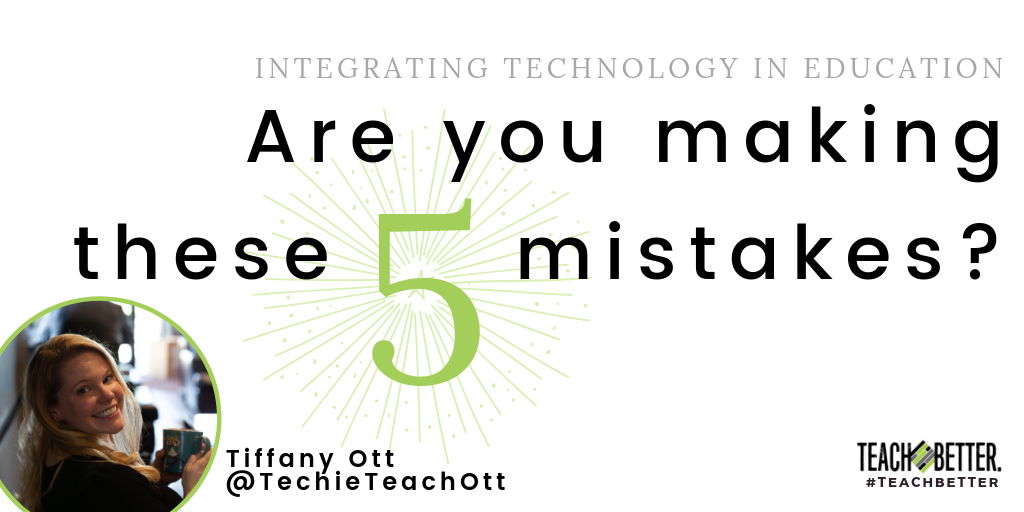In This Post:
- Benefits of technology integration
- If it doesn’t actually improve the learning process, it doesn’t really belong in your classroom.
- There is a danger in jumping on an edtech tool bandwagon too quickly.
- There are dozens of reason why a teacher would hold off on trying a new tech tool.
- It is really easy to fall into the trap of technology as a babysitter.
- The overwhelming majority of teachers have access to and regularly use technology in their daily life. It becomes very easy to assume that our students do also.
I talk a lot about educational technology. I think about it. I read about it. I present about it. I even, upon occasion, dream about it. Unfortunately, they aren’t good dreams about incredibly engaging, effective, and inspiring learning experiences designed to connect students to the world and make education relevant. No, these dreams are nightmares.
Have you ever had a dream that you walked into your classroom and couldn’t find any of the materials you prepared? Then, your admin comes in for an evaluation visit that you completely forgot about. To add fuel to the fire, you can’t remember your students’ names and are struggling to explain the concept of photosynthesis in a way that is anything but a jumbled mishmash of words that don’t make sense.
I have.
Maybe you used to wait tables as a side job. How about the dream where four tables just got sat at once, you forgot to ring in food for a table that has been there for 30 minutes, and you drop a tray of drinks on your way out of the kitchen.
Just because it is a new, cool looking tech tool, doesn't mean it deserves a place in your classroom. Click To TweetStress dreams are brutal, aren’t they? One particular one that drives me crazy is a stress dream I have about working in a school where technology integration is ineffective and even detrimental to student learning. Call me a nerd, but that is what I stress dream about. I know that tech support is just around the corner now, with IT Support Cardiff services, amongst others, are there for us. However, I’m not dreaming about it so my anxiety and stress culminate into one massive stress-dream ball.
So, without further ado, here are the top five mistakes that are on my mind (and in my dreams) when it comes to technology integration.
Mistake #1: Ooh, Shiny
It feels like you can’t scroll through Twitter, look at a teaching blog, or attend a professional development without hearing about a new edtech tool. Don’t get me wrong, there are tons of great options out there. But just because it is a new, cool looking tech tool, doesn’t mean it deserves a place in your classroom. If it doesn’t actually improve the learning process, it doesn’t really belong in your classroom.
Here is an idea, head over to Google and do a quick search: “Negative review ______ (insert name of the tech tool you just heard about)” Being a savvy consumer of edtch tools helps ensure your students are getting the best educational experience you can offer.
[scroll down to keep reading]Mistake #2: Not so fast!
I am a big fan of leaping before I look. In fact, I wrote a whole blog about how powerful it can be for educators to sometimes jump in with two feet, even when they don’t have all the answers. There is a danger, however, in jumping on an edtech tool bandwagon too quickly. Sure, that new technology you heard about in a morning PD might be awesome, but you probably shouldn’t go to your classroom that same afternoon and use it right away. Take some time to investigate it, play around with it, and brainstorm how to use it effectively.
Try this: Give yourself some limitations. If you tend to jump into tech tools too fast, set a rule that you need to have a 3 day waiting period between hearing about a new tool and actually using it in your classroom. Sometimes that little bit of time is all it takes for you to either eliminate the technology as not really effective at improving learning, or for you to brainstorm some awesome ways to use it.
Mistake #3: Sooooo slow
On the other end of the spectrum, is the mistake of delaying, and delaying, and delaying. There are dozens of reason why a teacher would hold off on trying a new tech tool. Maybe they are nervous about their technological expertise. Maybe they tried something in the past and it was an epic flop. Maybe they are disillusioned about the pervasive use of technology in classrooms. Maybe they feel like they don’t have support from their district, administration, or colleagues.
All of these are valid concerns and can be real barriers to successful technology integration. Here are some ideas that might help.
- Set a goal to incorporate a new tech tool into your classroom during a certain timeline. Maybe it is once a month. Maybe it is once in the entire school year. It doesn’t matter much what your frequency is, just make sure that you have a clear goal to focus your work.
- Find a buddy! Maybe there is a techie at your school who would love to geek out with you about tech (or just talk your ear off about what they are doing in their own classroom). Many innovative educators genuinely enjoy sharing their excitement, and would gladly act as a partner/mentor in your own tech attempts.
- Get help in any way you can. Depending on the tech tool you are considering, there are online tutorials, online courses, Facebook groups (like Teach Better Team’s group), and a whole myriad of other resources available to you. Can’t find what you need there? Ask an online PLN. Twitter is my favorite! My favorite suggestion for getting help? Email me. (Seriously!) I’d love to chat about what you’re are trying to do with technology and how I can help support you. (Reach me at tiffany@teachbetter.com)
Mistake #4 Babysitter’s Club
I know, I know. Sometimes things get crazy in our classrooms. There are times where I think I would give my left arm and maybe my right leg just for a couple more hours to get everything done I need to. There are definitely moments when I just need the 5,000 questions my students want to ask me or 3,000 stories they want to tell me to stop so I can get done what I need to get done. I have small groups to meet with, assessments to administer, writing conferences to finish – the list is endless! So what does this have to do with edtech? It is really easy to fall into the trap of technology as a babysitter. Students will generally leave you alone if you put them in front of a device and let them do something they find entertaining.
No, I do not have any problem with the edtech tools we use being entertaining, but I DO have a problem with edtech tools being ONLY entertaining.
Consider these three examples
Example 1: While you conference with students about their essays, the rest of the class is using a Hyperdoc you created that leads them through several activities on PBS Kids that are relevant to the content you are studying.
Rock on! This is NOT tech as a babysitter. This is purposeful technology use.
Example 2: While you meet with a group of students struggling with the current unit’s content, the rest of the class is told that they can go on PBS Kids. Without specific guidelines, the students gravitate towards the games that provide little to no educational value.
Uh oh, this is iffy territory. Sure, some of them might be learning from the experience. I would be willing to bet, however, that many of them are not.
Example 3: While you meet with a group of students to reassess them on the geometry unit that just ended, you tell the rest of the class they can get on Cool Math Games.
Danger, danger. I have yet to witness students getting real educational value from the Cool Math Games website. I’d love for you to prove me wrong and share a positive story, but I am pretty skeptical.
Mistake #5 Assuming Access
You know what they say about “assume”, right? If not, I encourage you to Google it and get a giggle. I like to avoid swearing here on this blog.
Technology is becoming pretty ubiquitous in the majority of the world. For United States citizens under the age of 50, people report, almost unanimously, that they use the internet. Worldwide, 57% of all people on Earth use the internet. There are very few parts of the world that report internet usage below 50%. Among college graduates in America, the category most educators fall into, home internet usage is at 95 percent. Among all of that data, one thing becomes clear: the overwhelming majority of teachers have access to and regularly use technology in their daily life. It becomes very easy to assume that our students do also.
Big mistake.
To further complicate the situation, having home internet and technology access can be a status symbol, especially in lower income or rural areas. This means that our students may not readily volunteer that they do not have computer access at home. So what do you do about it? Ask them, and ask them privately. I always include a question about home technology access and use in my start of the year Getting-To-Know-You” survey. A student is more likely to confess to a piece of paper that their family does not have access than they are in a face-to-face conversation. And they are very unlikely to admit to it during a whole class discussion.
Are you guilty?
Don’t worry, this is a judgment-free zone. If you found yourself thinking, “I do that.” at any point in this blog, great. Seriously! It matters little where you are right now in your effective technology integration journey. What matters most is where you go now. I’d love to hear about your journey, your struggles, and your successes – why don’t you reach out to me through email (tiffany@teachbetter.com) or on Twitter (@TechieTeachOtt) and we can chat about it.
About Tiffany Ott
Tiffany Ott is the Director of Curriculum Development with the Teach Better Team, a high school math teacher in Ohio, the founder of #MasteryChat, and an educational technology fanatic. She just can’t get enough of teaching and learning!
Whether it’s connecting with a teacher struggling to make mastery learning work, writing about education, designing units, or speaking up on a stage to teachers who want to change the world with awesome teaching, she is hooked on all things education.




